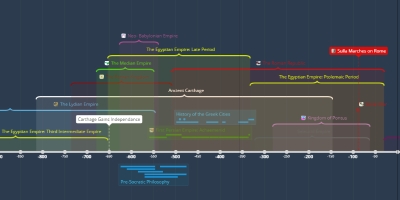Zeno of Elea (sep 11, 490 BC – mar 30, 430 BC)
Description:
All that is really know of Elea and his works is published in Plato's 'Parmenides' (Cautionary note, that the date of his death is unknown, various awful sources have claimed that he lived to the age of 60, so just to mark things off on the timeline I have placed his death at 430 BC). He is best known as a defender of Parmenides:"Parmenides rejected pluralism and the reality of any kind of change: for him all was one indivisible, unchanging reality, and any appearances to the contrary were illusions, to be dispelled by reason and revelation." (Huggett 2017)
He defended Parmenides through his various 'Paradoxes'. Huggett explains that this form of defence effectively came from ridicule of his beliefs, he wanted to demonstrate that arguing in favour of plurality is equally if not more absurd. They do this by demonstrating that to define time and space is to begin an infinite regression:
"If there are many, they must be as many as they are and neither more nor less than that. But if they are as many as they are, they would be limited. If there are many, things that are are unlimited. For there are always others between the things that are, and again others between those, and so the things that are are unlimited." (Simplicius(a) On Aristotle’s Physics, 140.29)
If I define a spesific time and space, there is always further divisions to make between space A and space B. Huggett explains: "if you suppose that the world contains many things, then you are faced with a contradiction, for the collection must be both finite and infinite—finite because it contains a definite number of things, and infinite because they are dense. " (Huggett 2017). Zeno's paradoxes visualise this dilemma well.
The first Dilemma 'Achilles and the Tortoise' (displayed in picture 2 (poorly due to square cropping), goes like this: Achilles is racing a Tortoise which has a head start, he begins at A, the Tortoise at B. By the time Achilles reaches B the point in which the Tortoise had reached when he began, the Tortoise would have advanced to point C beyond that. Achilles then reaches point C, yet in the time it took to reach this point the tortoise is at point D; and so on and so forth. Zeno suggests we are in an infinite regression demonstrating the illogicality of plurality.
The second paradox is the flight of an arrow. Supposing that time consists of a sequence of instances 'nows', then the arrow in flight is in fact in every instance of its flight actual at rest; at rest in each single instance.
The third dilemma (shown in the third image) is the 'Stadium Dilemma'. The dilemma goes as such: by the time it takes the front B to reach the final A (which are stationary), the front B would have passed all the Cs (moving int he opposite direction at the same speed). The issue is; how is this possible? Now this problem Waterfield (2000) proposes may have two interpretations. The first provided by Aristotle is remarkably simple: it is slower to pass a stationary object than one which is moving towards you. This is of course remarkably simple to answer. However, Waterfield explains that some scholars have proposed a more complex interpretation of the problem, and suggest that Aristotle has actually misunderstood Zeno; this is born out of the belief that Zeno could not possibly be so naive. The interpretation goes like this:
"Suppose that each of the blocks As, Bs and Cs is an atomic unit of space, and suppose that it takes one atomic unit of time (let's call it a 'click') for one atomic unit of space to pass another atomic unit of space. In one click, then, the leading B has moved from being opposite the second A to being opposite the third A. But in the same click it has moved from being opposite none of the Cs, to being opposite the second C. When, then, was it opposite the first C? It looks as though the click, which is by defintion atomic (that is, indivisible), has to be sub-divided, and by the same token so do the supposedly atomic blocks." (Waterfield 2000, p.72).
The problem, which Waterfield immediately clarifies, is that we only know of the paradox in the first place from Aristotle, so we only have his interpretation of the dilemma. Although it seems rather plausable - perhaps more so because of the alternative interpreation.
Added to timeline:
Date:
sep 11, 490 BC
mar 30, 430 BC
~ 60 years
